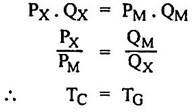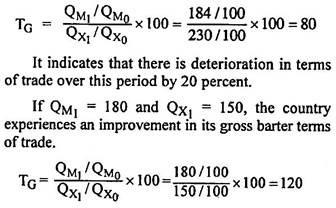The gross barter term of trade is a ratio of total physical quantities of imports to the total physical quantities of exports of a given country.
Given the above definition, the gross barter terms of trade in case of particular commodities can be measured at a point of time through the formula given below:
TG = (QM/QX) × 100
Here TG is gross barter terms of trade, QM is aggregate quantity of imports and QX is the aggregate quantity of exports. Higher the magnitude of TG over 100, better are the gross barter terms of trade. It implies that the country can import larger quantities from abroad for the given quantities exported to other countries. On the opposite, if the magnitude of TG is less than 100, it means the gross barter terms of trade are unfavourable to a given country and it can import smaller quantity of goods from abroad for the same quantity of exports.
ADVERTISEMENTS:
If the balance of trade of a country is in a state of balance and the total receipts from export of goods are exactly equal to the payments for import of goods, the net barter terms of trade will be equal to the gross barter terms of trade.
Total Receipts from Exports = Total Payments for Imports
When there is a deficit or surplus in trade balance, the gross barter and net barter terms of trade will differ from each other (TC <> TG).
ADVERTISEMENTS:
When trade involves a large number of commodities and changes in terms of trade have to be compared between two periods, the gross barter terms of trade are a ratio of indices of quantities imported and the quantities exported.
In such a case, the gross barter terms of trade can be determined as:
Here QM1 and QM0 are the quantity indices of imports in the current year (1) and base year (0) respectively. QX1 and QX0 are the quantity indices of exports in the current year (1) and base year (0) respectively.
ADVERTISEMENTS:
Given the quantity indices of imports and exports as 100 each in the base year 2010 and 184 and 230 respectively in the current year 2015, the gross barter terms of trade have turned unfavourable for the given country-
The above illustration shows that the gross barter terms of trade have improved for the given country by 20.00 percent over this period.
Criticisms:
The concept of gross barter terms of trade was considered better than the concept of net barter terms of trade. But there are certain deficiencies in it that resulted in its criticism.
This concept has been criticized on the following grounds:
(i) Aggregation of Goods, Services and Capital Transactions:
The gross barter terms of trade attempted to remove the deficiency of the net barter terms of trade by aggregating all exports of goods, services and capital in the index of export quantities. Similarly, the imports of goods, services and capital were aggregated in the index of quantities imported. The lumping together of these non- homogeneous quantities was both unreal and impractical. It was because of this reason that this concept of terms of trade came to be rejected at the hands of economists like Jacob Viner and Haberler.
(ii) Faulty Index of Welfare:
ADVERTISEMENTS:
A higher ratio of quantity index of imports to the quantity index of exports is sometimes regarded as an index of a higher level of welfare from trade because the country obtains larger quantity of importable good per unit of exportable goods. But this is not necessarily true. If there are such changes in tastes and habits of a people that even a smaller quantity of imports yields greater satisfaction, the community may derive greater welfare despite an unfavourable gross barter terms of trade.
(iii) Neglect of Productivity:
It is possible that a country has unfavourable gross barter terms of trade but that is caused by increased factor productivity in the export sector. The increased factor productivity still indicates the gain from the point of view of the exporting country. The impact of improvement in productivity has been overlooked in this measure of terms of trade.
(iv) Neglect of Qualitative Changes:
ADVERTISEMENTS:
The gross barter terms of trade ratio undoubtedly takes into account the physical quantities of imports and exports but ignores the fact that there might have been qualitative improvements in production in the exporting and importing countries. Such changes can have very significant effect on the welfare, yet these are not reflected through the gross barter terms of trade.
(v) Neglect of Capital Movements:
The international capital movements have quite important influence on the balance of payments and general economic condition of a country. This vital factor, however, has not found proper expression in the measurement of gross barter terms of trade.


